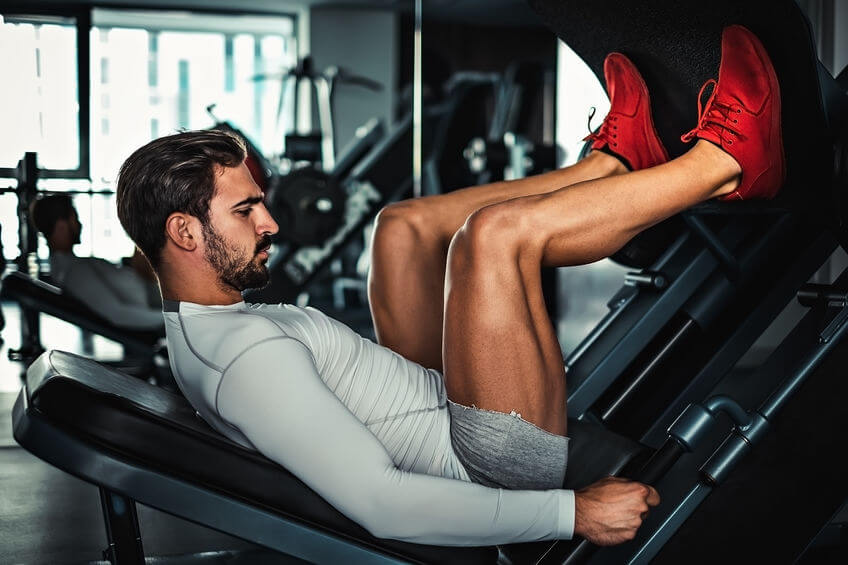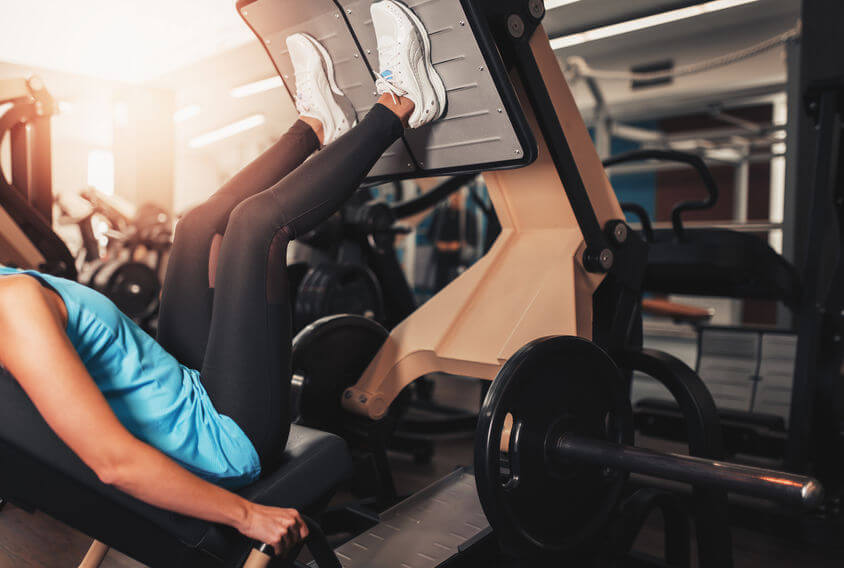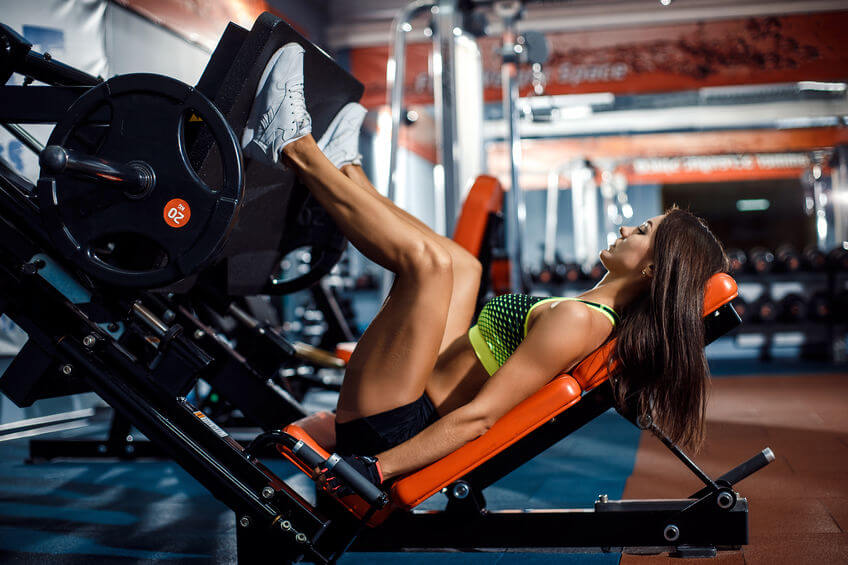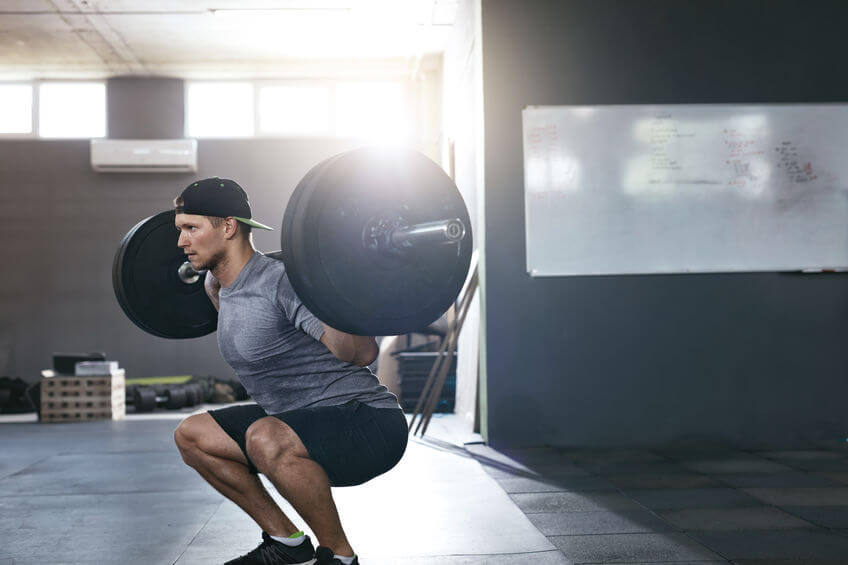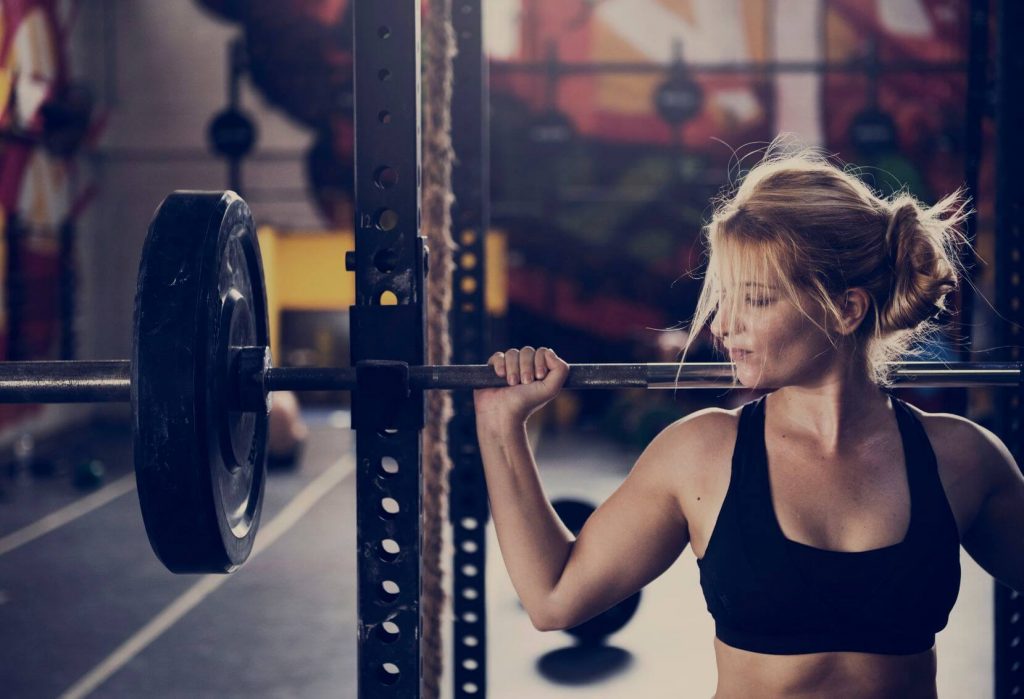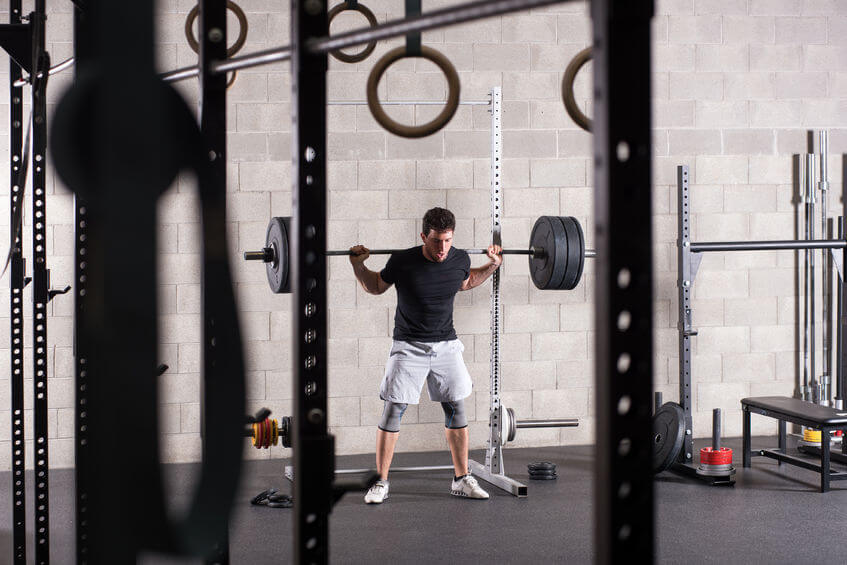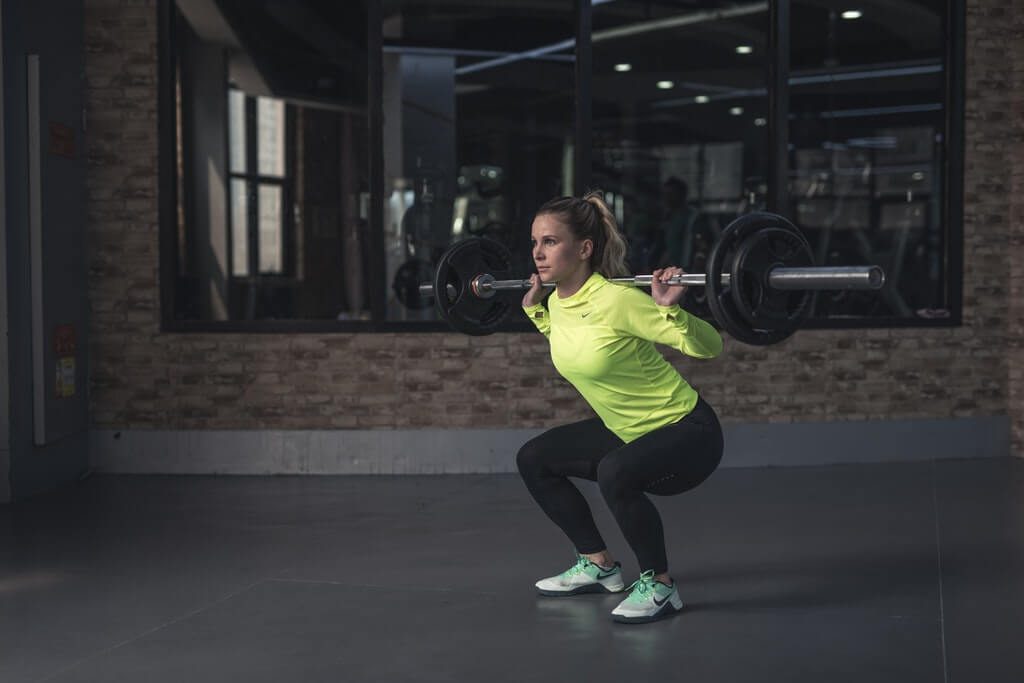To Leg Press or To Squat? That is The Question!
I’m sure you know how hard it can be to choose which exercises to use in your fitness regime.
But don’t worry, I’m here today to help you clear up one of the biggest questions newcomers and veterans alike ask about leg training:
Which is better, squats or the leg press?
Which will lead to greater gains, which will be safer, and which will give you a bigger boost to your overall athleticism?
We’ll answer this today, as well as go into some proven ways you can optimize both in your workouts.
Contents
To Leg Press or To Squat? That is The Question
The leg press is sometimes advocated by fitness professionals in place of the squat.
Even for perfectly healthy trainees, with no histories of mobility issues or joint pain/injuries, the leg press is often recommended.
The claim goes that the leg press has a better risk/benefit ratio than the squat and that it can even lead to increased performance.
Alternatively, many coaches favor the squat. It has more real-life transference, they argue. It elicits greater hypertrophy and strength gains and allows the lifter to run their joints through a more natural range of motion as they trace a proper bar path rather than a machine’s pre-set movement pattern.
This can be confusing. How do you make sense of it?
Let’s take a look at the science behind this question, alongside some anecdotal and expert opinions on the matter.
The Leg Press
Leg press devotees claim that leg press machines give lifters all the benefits of barbell squats.
They allow you to develop quadriceps, glutes, hamstrings, and calves, alongside the smaller muscles of your ad- and abductors.
There are various designs of leg press, from seated cable machines to plate-loaded hack squats. Though there are some differences between each, they all do broadly the same thing, working the same muscles with similar stimulation and under similar patterns.
Variations in foot placement can change the emphasis placed on each muscle group, the same as with a squat. Variations in load, rep range and tempo can allow you to work various different energy sources, with various different goals- once more, as with the squat.
This is all true, to a point.
The muscles mentioned above are stimulated by the leg press machine. You will grow them all larger and stronger if you regularly use the leg press and stick to the principle of progressive overload.
As you add weight to the leg press machine, you will grow stronger and hypertrophy should occur.
However, it’s not quite as simple.
How can You Choose?
There is actually a lot to differentiate the leg press from the squat.
No matter what variation you go for, which model you use, or how well it is designed, the nature of the leg press means that it runs to a pre-set motor pattern.
This is determined by the model’s designer to fit everybody well enough, but nobody perfectly. It is built for an ‘average’ body, and arguably there is no such thing.
Why does this matter?
There is a high chance that the motor pattern won’t be optimal for you.
There’s a decent chance that it won’t even be that good for you, over time. You will be programming movements unsuited to your body and reinforcing those habits and patterns time after time as your training progresses.
You may create postural issues and movement dysfunctions. You may push your joints out of place, or place stresses on them in directions and manners for which they are entirely unsuited.
This can have quite profound effects on your overall health, fitness, and mobility.
Your risk of injury will be quite high as you use a leg press; it will get a lot higher the more you use it and the more you push your legs and joints through ranges of motions and motor patterns that don’t suit them.
Long-term joint and spinal issues can occur, and you will likely enter into a cycle of injury, rehab, and injury once more.
Some Specific Risks
There are a few quite specific issues with the leg press’ range of motion.
The bottom position in the leg press, as your knees are at their most bent, can cause some major issues.
Your lower back will be in a precarious position as it will be in an overly exaggerated flexion, under some quite serious loads.
Why is this?
The leg press is built to offer a stable platform.
Though this may sound good and may look a lot safer than standing under a heavy bar for the squat, the opposite is true. You can use much larger loads on the leg press, meaning that your body has to deal with many times the amount of weight as will be typical for a squat.
As your knees come in towards your torso, it’s quite common to raise your back from the seat. This will open the spine to quite intense compressive forces as that increased load is pushed into an unnatural position.
From here, damage to the spinal disks and the muscles of the lower back can be common.
Why does this matter?
It is putting this much load into your knees, ankle, and hips whilst they are not in their optimal alignment that will often lead to many of the issues mentioned above.
The Load Itself
I’ll jump in and use myself as an example here.
On a good day, with a good-ish program, I can squat around 440 pounds with decent enough form.
This is far from being a world record, and I’m always looking to get stronger but I’m pretty happy with it for the moment.
Any day of the week, unrested, with any program, I can hit 1300 lbs on the leg press for reps. I could probably hit around 2200 lbs for a single rep, except that the machine itself cannot hold that many plates.
This isn’t to show off. As mentioned above, I’m far from the world’s strongest lifter. I’m not even the strongest lifter at my local gym.
This is my point: the leg press is easy. If I can hit close to five times the amount of weight on it that I can squat, something is amiss.
What does this mean for you?
This feeds into the above problem: the stresses put into your joints are too high on the leg press, whilst the stimulating factor into the muscles themselves is a lot lower than the squats.
What looks like a safe yet workable exercise is quite the opposite.
On the other hand, squats are safe when performed correctly, which we’ll go into more detail below.
They actually keep your knees safer than they would be without doing them. They increase stability and strength through your legs and strengthen your soft tissue, thus making everything involved far more robust and far less susceptible to injury.
They do all this whilst controlling more than adequate loads for strength gains and hypertrophy.
Common Mistakes that You Can Avoid
This being said, there are some things you can do to make the leg press a lot safer.
I use it routinely myself, as a higher rep accessory after my heavy squats.
I suffer no negative side effects and feel no pain, simply by avoiding the following, common mistakes:
1. Using too Much Weight
As much as I can boast about how many plates I can rack up on a hack squat, this isn’t my usual method. As I said above, I go light, for higher reps. I never go below 8 reps per set, and quite often go for 12+. This naturally keeps the load low.
If you find yourself unable to control the movement, or unable to comfortably hit 8 reps, you will want to lighten the load.
Proper form is what will keep you safe here: it will help you to avoid the other common mistakes on this list and will allow you to keep a more accurate eye on how your joints are coping in real-time.
2. Raising Your Buttocks from the Seat
Keep your buttocks in place on the seat.
If you bring them up – typically to increase your thrusting power – you will place your legs at the wrong angle. This can be very damaging to your ankles, knees, and even hips.
Position the seat or the plate at a position that keeps your knees and buttocks comfortable.
3. Keeping to a Short Range of Motion
It’s quite common to see people overloading the weight and just pumping the leg press a foot or less towards the top end of the motion.
This is ego lifting and should be avoided. It won’t gain you any strength or muscle mass, and it may represent more weight than your joints can cope with.
Keep the weight down and move through a full range of motion, bringing yourself into a position similar to the full depth of a squat.
4. Pushing Hands into Knees
Don’t push your hands into your knees for extra strength.
This is a trickier one, though. I actually don’t mind seeing this for the first rep, getting yourself into position from what is essentially a mechanical deficit.
However, it should end here.
Every other rep should be legs only, without any upper body assistance. You’re doing your upper body no good, eliciting no gains, and you’re just robbing your legs of the tension they need to grow.
Again, don’t ego lift. If the weight is too much, bring it down.
5. Breathing
Basically, remember to breathe. It may sound basic, but you see lifters holding their breath and tensing up all the time.
Whilst you do need a good breath and brace for lower reps of harder compounds, you don’t for high rep sets like the leg press.
Exhale as you press, inhale as you lower the weight.
The Squat
There is no other exercise that can mimic what the squat delivers, especially not one using a machine like the leg press.
Try a session on each. Go to failure in the squat.
Rest a few days, even a week, and go to failure on the leg press.
Trust me: the squat will wipe the floor with you. You’ll likely be fine after the leg press.
This is because the level of central nervous system (CNS) activity, and from there CNS fatigue, is unparalleled in the squat.
The muscular stimulation and the growth elicited cannot be replicated outside of the squat. The psychological demand of running through heavy squats is intense.
In addition, the improved coordination, proprioception and balance, the skeletal loading and increased bone density, the connective and soft tissue stress and overall conditioning you get with the squat are all available only with the squat.
What does this mean for you?
It will take it out of you. But once you recover, and when you’ve been squatting regularly for years, these extra stresses will give you added strength and additional benefits that the leg press simply cannot deliver.
Advantages of the Squat that You can Make the Most Out of
There are numerous mechanical advantages that the squat has both in general and over the leg press in particular.
In fact, there are mechanical advantages inherent to the squat that only squats can give you, and these will filter out into every aspect of your athletic life.
Muscular Recruitment and Motor Stability
Though the leg press is technically considered a compound exercise, like the squat, it performs more like an isolation move.
Squats require full extension at the lifter’s hips and knees.
Alternatively, the leg press only goes to full knee extension: the hips are flexed throughout the movement.
This will naturally cut out a great deal of muscle mass, specifically across the glutes and hip flexors.
In addition, let’s return to the stabilization factor needed to perform the squat. The importance of consistently working and improving stabilization cannot be overstated: it has a great deal of carryover into both athletic endeavors and general life.
Improvement will decrease the likelihood of most injuries in all situations.
What does this mean?
The squat improves stability. The leg press does not.
Force Transference
Force transference is also a big deal when comparing the two.
The leg press eliminates any balancing training on the athlete’s part. Balance is needed in any sporting endeavor, any other form of lifting, and in day-to-day life.
As above, squats require balance and stability. In addition, the transference of force that the squat delivers through this balance, through the body, is perfect training for any athlete.
The leg press elicits nothing like the level inter- and intra-muscular coordination as the squat, and brings about very little muscle recruitment in comparison.
The maximum effort in the squat has a direct correlation with both jumping height and sprint performance in elite athletes.
The more they can squat, and the harder they work at the squat, the more these measures improve. This is in large part down to exactly this kind of force transference training.
Here we can see that the squat aids in explosivity, a core component of many athletic disciplines, from martial arts to running, cycling to rugby: squatting heavy will improve your athleticism and help you to reach your goals.
Mechanical Performance and Longevity
There are some weaknesses to the overall performance and longevity of your body’s mechanics if you prioritize the leg press over the squat (please note that this is a matter of prioritization: the leg press has its place, it just needs to be secondary to squats in order to allay the worst of these symptoms).
If you go with the leg press over the squat, you will likely experience weakened hip extensors.
As hip extension is such a large part of everyday mobility, and of any athletic endeavor, this is obviously a fault you want to avoid.
If you want to improve your athletic ability and make it into old age with your hips in better functional working order, the squat will be your best friend.
Leg pressing, and machine work in general, may lead to a decrease in free weight functional strength.
As I’ve mentioned, there is little relationship between my own squat and leg press numbers. Improving my leg press really won’t improve my squat all that much, just like working a pec-deck won’t give you a good bench press.
If I only focus on my leg press, I will only ever be able to call myself a novice lifter.
Common Mistakes
As with the leg press, there are some things you can do to make the squat both safer and more beneficial.
You will always get more out of the squat if you perform it with good technique at appropriate loads.
How can you do this?
Simply avoid the following, common mistakes:
1. Not Breathing and Bracing
I told you not to hold your breath on the leg press. The reverse is (sort of) true for the squat.
You want to practice your breath and brace if you want to squat heavy.
One of the key differences that make the loading so much heavier in the leg press than the squat is core stability. You are given it for free on the leg press; you have to work for it in the squat.
For lighter weights, exhale each time you extend upwards out of the squat. Rebreathe at the top. For heavier sets (5 reps or fewer, generally speaking) breath and brace.
Get as many lifts out of that first breath as possible.
2. Cutting Your Range of Motion
Let’s talk about ego lifters again. If you load the bar up so heavy that you can’t squat low enough, lighten the bar.
If you have mobility issues that cut your range of motion, prioritize overcoming these.
A full range of motion should go from standing at full extension to squatting low enough that your knees are level with your hips, if not slightly lower.
This will ensure that all of your squatting muscles, particularly your glutes, get the work they need.
3. Breaking too Much at the Knees
You want to break your knees forwards first (push them forwards and outwards, not literally break them!), then hinge your hips back as you descend.
However, you want to push your knees out to their limit whilst not going too far forward.
Why does this matter?
Pushing them too far forwards will put unnecessary strain on them in a range of motion they are not suited too.
It will also often lift your heels, limiting the depth of your squat, and may cause trauma to the ankles.
Speaking of which…
4. Bringing Your Heels up
As above, this may be due to an incorrect knee position. Alternatively, it could be a mobility issue, in which case you’ll need to work on your overall mobility and flexibility before progressing much further.
Bringing your heels up will weaken your lift. You want to press through your heels, transferring power into the ground, and from the ground up, through that stable position.
For a stronger lift, keep your heels planted and dig them into the floor.
Keeping your heels down will also help to keep all the relevant joints in position, further promoting efficient power transference and decreasing the risk from injury.
5. Leaning Forwards
It can be tempting to lean forwards. This brings more of the lift into your lower back, which is incredibly strong. It can also make you feel like you’re getting lower – any time your head comes down to the ground, you feel like you’ve hit a deep squat.
Simply bending over isn’t enough: you need to sink down into the correct position, at a full squat, with open hips. Then, and only then, will you have hit a deep squat.
In addition, you want to keep the bar in line with your center of gravity. This is true of every lift, not just the squat. It’s where you’re the most stable, and where you will have to wrestle the least with any external pressures not relevant to a true bar path.
If it comes out in front, you have to wrestle it back. If it goes too far behind, vice versa.
If you lean forward, the bar will begin to weigh your torso forwards. This can lead to a rounded back, to neck issues and, injury aside, simply to a failed lift as you don’t manage to bring the bar back to its correct alignment.
Keep a neutral spine, with your eyes forward, to avoid any of this from happening.
Conclusion
The leg press is not a complete write-off, not by any stretch of the imagination.
There are many advantages to performing it, either instead of or as well as the squat. It is far easier to learn to perform to an efficient standard, without coaching.
It will elicit hypertrophy and strength gains, as long as lifters take heed of the principal of progressive overload.
It is also great for when you’re fatigued at the end of a workout and just want a good pump: try throwing some sets in after your squats, when you won’t have to think too hard about technique and you can just hit those reps for a final, accessory blast.
The leg press also has some distinct advantages in a clinical or rehabilitative context.
If somebody simply cannot perform a squat for medical reasons, the leg press is a rough and ready alternative.
However, the leg press isn’t to be taken seriously as a true alternative to the squat. When lifters can sit on a machine and push literally five times the weight they can squat, eyebrows should be raised.
What does this mean for you?
There is no exercise to match the squat in terms of muscular stimulation, motor control demands, bone density benefits, and full-body stabilizing tension.
It cannot be performed at the same weight as the leg press simply because it is a harder, more taxing, more structurally challenging move: it should be celebrated because of this.
The squat’s potential hypertrophy and strength gains are far more profound than those offered by the leg press.
The central nervous system demand is almost without parallel (the only exercise I can think of that does more to the CNS is the deadlift!) Your motor control and your body’s ability to work, brace and ultimately perform under load will be greatly improved by regularly squatting through a series of rep ranges.
The final verdict?
You will be a better athlete for favoring the squat and its variations as your primary form of lower body exercise.



